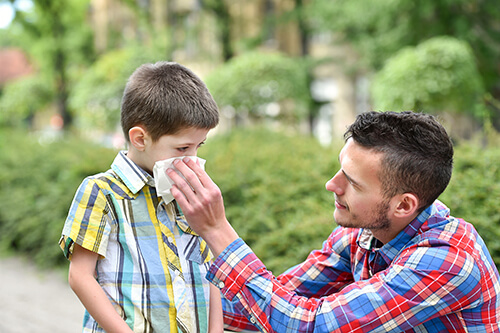Researching the Far-Reaching Effects of Wildfire Smoke – Ways to Protect Kids Against Air Pollutants
7.22.2024 | Empress Rivera-Ruiz

As Washington enters the hottest and driest months of the year, the risk of wildfires and smoke exposures increase. The environmental effects of wildfires are devastating for Washington forests, with fires that can affect thousands of acres of wildland and may require the efforts of legions of firefighters over several months to extinguish. Additionally, wildfire smoke exposure can cause health risks to communities miles away from the fire's origin.
Dr. Mary Crocker, pediatric pulmonologist and researcher at Seattle Children’s Research Institute’s Center for Respiratory Biology and Therapeutics, investigates how to protect kids and teens with asthma from indoor and outdoor air pollution, and studies wildfire smoke exposure in children. While wildfire smoke is an annual seasonal occurrence, patterns of frequency, intensity and lasting effects have been changing over time, due to climate change and many other factors.
Dr. Crocker shares insights into her research and the patterns she’s seen reflected in the pediatric community as wildfire conditions continue to change.
How can wildfire smoke exposure affect families?
Wildfire smoke exposure can affect individuals in different ways, with those who live with respiratory conditions considered to be a sensitive group. While people of all ages can be affected, the pediatric population is one of the groups most at risk, as children under the age of 18 are also classified as a sensitive group. Other at-risk individuals include pregnant persons, older adults and those with chronic medical conditions.
Children might experience cough, nasal congestion, eye irritation, trouble breathing or increased respiratory infections due to wildfire smoke exposure. Conditions such as asthma, cystic fibrosis and chronic sinus disease can all be made worse by poor air quality. Research has shown that the risk of needing the emergency room or hospitalization for asthma or other respiratory symptoms increases during and after wildfire smoke events.
Which communities are most at risk?
Those who are close to the site of wildfires will certainly be impacted the most. But many may not realize that even if you are not right next to the fire, smoke plumes can travel many miles. Communities that are safe from the path of the fire may still be at risk for smoke exposure.
Under-resourced communities are also at risk. For example, outdoor workers and individuals who are unhoused are much more exposed to wildfire smoke. Those who can stay indoors but lack access to proper air cleaning or who live in older “leaky” buildings (which may have gaps or cracks around windows and doors that allow smoke to seep in) are also at risk for negative effects of exposure.
What are some ways families can lessen their exposure to wildfire smoke?
While it is generally advised to stay indoors while skies are smoky, the air quality could still be poor even if the skies look clear. There are easy at-home options available to help lessen exposure:
- Check the air quality index (AQI) of your area frequently during wildfire smoke season through reliable sources such as Airnow.gov. The higher the AQI, the more pollutants in the air. Each level of the AQI is linked with certain actions you can take to protect yourself and your family, depending on your level of risk. These may include avoiding physical activity outside or avoiding going outdoors entirely. Depending on the AQI on a given day, you can choose between activities like staying indoors to enjoy a movie together or outdoor activities like visiting a nearby park.
- Reduce the amount of smoke inside your home. You can do this by running a high-efficiency particulate air (HEPA) filter in your home. HEPA filters are great at reducing indoor pollution and are designed to filter out particular particles and chemicals found in wildfire smoke. Another more affordable option is to make your own box fan filter, which can also significantly improve indoor air quality. Alternatively, running an air conditioner or heater with a high minimum efficiency reporting value (MERV) rating can also filter indoor pollutants, including smoke.
How does wildfire smoke exposure tie into your research?
Most of my research has been specific to asthma. I am really interested in exploring strategies to help protect kids with asthma from environmental triggers, which flows naturally into my work researching wildfire smoke exposure from a clinical researcher lens.
There is a program in King County sponsored by Public Health – Seattle & King County that does home visits for children with asthma, in partnership with community health workers. These teams evaluate homes for potential asthma triggers — think mold, pests, cigarette and wildfire smoke — and provide education and resources for families to help manage this condition. My research focuses on these types of programs and their impact.
I am very excited about a new project we are launching this year. We are developing a “Wildfire Smoke Action Plan” tool for families that have kids with asthma to use during wildfire smoke season. This plan would help families prepare to protect against wildfire smoke exposure. It will include personalized tips to minimize exposures and ways to recognize symptoms. Once this tool is finalized, we are hoping to roll it out in the community and get feedback from parents on how well it works for them. Ultimately our hope is to empower families to protect themselves and reduce the impact that wildfires have on their child’s health.
Learn More
If you’d like to learn more about Dr. Crocker’s research, visit her website: Crocker Research Program.